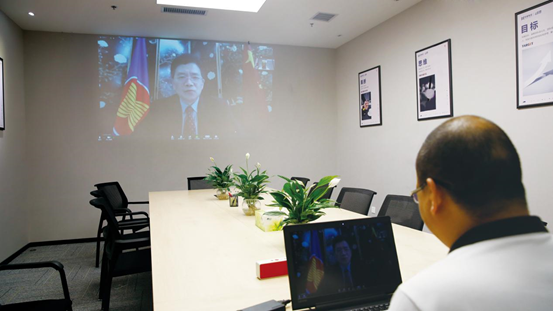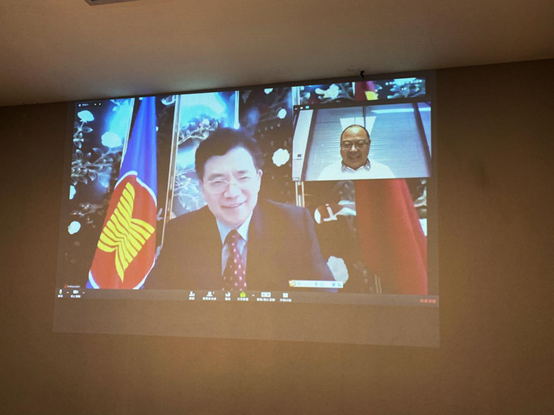

In recent years, with the continuous breakthrough of the Internet, big data, artificial intelligence, smart city, E-commerce and other modern information technologies, digital economy has become a new driving force for global economic development.
The theme of China-ASEAN cooperation in 2020 is “digital economy”. On June 12, the opening ceremony of the Year of China-ASEAN Digital Economy Cooperation was successfully held online. Does China-ASEAN Digital Economy Cooperation have great potential? What are the prospects of China-ASEAN economic and trade cooperation? On July 23, China-ASEAN Panorama Magazine Agency interviewed H.E. Deng Xijun, Head of the Chinese Delegation to ASEAN and Ambassador Extraordinary and Plenipotentiary, on the above issues.

H.E. Deng Xijun, Chinese Ambassodor to ASEAN, received an exclusive interview with China-ASEAN Panorama Magazine Agency online
China and ASEAN have the will and potential to develop digital economy
“With the rapid development of digital economy, the economy and society have been profoundly reshaped. Digital economy is also becoming the focus of China and ASEAN, showing vigorous development vitality,” said ambassador Deng Xijun.
In recent years, China and ASEAN have actively carried out E-commerce cooperation and strengthened cooperation in cross-border E-commerce credit, customs clearance, inspection and quarantine, warehousing and logistics, and technical services. The two sides have carried out point-to-point cooperation in urban intelligent management, information sharing and sustainable ecology. Alibaba, Jingdong, Tencent and other Chinese Internet giants have invested in ASEAN countries and cooperated with local enterprises, which not only helps ASEAN products enter the Chinese market, but also creates a large number of jobs for the region and drives economic development. Digital economic cooperation between the two sides has been deepening and becoming an important driving force for regional economic development.

“The sudden outbreak of the COVID-19 has brought difficulties to many countries, but it has also brought opportunities. Digital economy is one of them. Digital technology has played an irreplaceable role in preventing the epidemic, resuming work and production, and ensuring people’s livelihood. Besides, it will become a new growth point of bilateral cooperation,” said Deng Xijun.
During the epidemic, the agricultural products of ASEAN countries were sold well in the Chinese market through E-commerce platforms. On June 9, 2020, Jurin Laksanavisit, Deputy Prime Minister and Commerce Minister of Thailand personally introduced Thai fruit on T-mall livestream platform, attracting more than 9 million people to watch and selling more than 12,000 durians. It can be seen that the cooperation between China and ASEAN in digital economy has broad prospects.
“In 2019, the added value of China’s digital economy reached RMB 35.8 trillion yuan, accounting for 36.2% of GDP, and it is expected to reach 50% by 2025. The potential of digital economy in ASEAN countries is also great. The overall scale of ASEAN countries reached US$ 100 billion in 2019, and is expected to reach US$ 300 billion in 2025, accounting for 8.5% of GDP. At present, there are 360 million Internet users in ASEAN countries, and it is estimated that 10 million Internet users will be added each year in the next 15 years. It can be said that a larger and better consumer market is taking shape. China and ASEAN both have the will and the potential to develop the digital economy hand in hand, and the future is promising,” said Deng Xijun. In the future, the two sides can strengthen cooperation on digital economy in following aspects:
First, enhance the application of digital technology in preventing the epidemic and resuming work and production, and share policies, measures, practices and solutions in digital epidemic prevention.
Second, strengthen the construction of digital infrastructure, and enhance cooperation in 5G, Internet of Things, artificial intelligence, industrial Internet and other fields.
Third, support entrepreneurship, innovation and industrial digital transformation, promote the development of digital, network and intelligent manufacturing industry, and jointly maintain the stability of industrial chains and supply chains.
Fourth, promote the development of cross-border E-commerce and create a more favorable policy environment to further expand bilateral trade in goods and services.
Fifth, push forward the development of smart city, and advance the innovation of urban management means, modes and mindset by using advanced technologies such as big data, cloud computing, blockchain and artificial intelligence.
Sixth, deepen cyberspace governance, strengthen cyberspace security capacity, and encourage the construction of a peaceful, secure, open and orderly cyberspace.
China-ASEAN economic and trade cooperation bears great resilience
The rapid development of China and ASEAN in digital economy not only helps countries of both sides to quickly restore economic and social order, but also injects a strong impetus into China-ASEAN bilateral trade. In the first half of 2020, the total import and export volume of goods between China and ASEAN reached RMB 2.09 trillion yuan (about US$ 300 billion), with a year-on-year increase of 5.6%, making ASEAN the fastest growing region among China’s major trading partners. ASEAN replaced the EU for the first time and became China’s largest trading partner.

“The COVID-19 has a serious impact on global economy and trade. Under this situation, the achievement is hard-won and exciting, reflecting the strong resilience of China-ASEAN economic and trade relations and injecting a great impetus to global economic recovery,” said Deng Xijun. The gratifying achievements made by China and ASEAN are mainly due to the following factors:
First, China and ASEAN firmly support multilateralism and free trade, the “breathing system” of bilateral economic and trade relations. Both China and ASEAN are in-depth participants, full beneficiaries and strong supporters oflobal trade. In recent years, global protectionism has risen and trade friction has intensified. However, China and ASEAN have not been affected by it. They have always maintained close cooperation, actively maintained multilateralism and free trade, and further facilitated bilateral trade and cooperation.
Second, China-ASEAN Free Trade Area (CAFTA) has played a key role, becoming the “movement system” of bilateral economic and trade relations. Since its establishment in 2010, CAFTA has effectively promoted the process of trade and investment liberalization and facilitation between China and ASEAN, and provided a strong impetus for regional economic integration and development. In 2019, the Protocol to upgrade the CAFTA came into full force, further lowering the threshold in rules of origin, trade facilitation, trade in services, investment and other fields, which helped to release more dividends from the CAFTA. In a recent survey of the condition of Chinese enterprises in ASEAN countries, the Chinese mission to ASEAN found that relevant enterprises had a high recognition of the CAFTA, and related preferential policies were not affected during the epidemic.
Third, industrial chains and value chains of both sides are highly integrated, and the efficient flow of commodities, funds and technology serves as the “circulation system” of bilateral economic and trade relations. Industrial chains of the two sides are highly consistent. There are strong upstream and downstream ties, forming a pattern of economic and trade development in which both sides are highly integrating. China has advanced technology and sufficient skilled workers, while ASEAN countries have the advantages of raw materials of high quality, low price and low costs. Therefore, both sides and many transnational companies have adopted the “China+1” strategy to promote mutual benefit, win-win situation, and economic integration.
“Despite the adverse impact of the epidemic and the rising protectionism, we believe that China-ASEAN economic and trade cooperation will be closer and more stable and bilateral trade will remain stable with the support of the above several important systems. China will work with ASEAN to strengthen economic and trade policy exchanges and coordination, share experience in boosting the economy under the epidemic, and further enhance the level of bilateral economic and trade cooperation. We will also actively promote the signing of the Regional Comprehensive Economic Partnership Agreement (RCEP) in 2020, to fully release the potential of regional trade and investment, thus making an important contribution to economic recovery after the epidemic,” said Deng Xijun.
ASEAN will take the lead in enjoying the dividend brought by China’s economic recovery
China and ASEAN are important economic and trade partners for each other. At present, with the gradual disappearance of the epidemic, both sides are making positive efforts to promote the resumption of work and production, prevent and control the epidemic, and resume exchanges and cooperation. On June 8, 2020, China and Singapore have opened a “fast track” and built a “green channel” to facilitate the trade of goods.
Deng Xijun said that in view of the adverse impact of the epidemic on the economy and society, China will join hands with ASEAN to further strengthen trade and investment cooperation and promote regional economic recovery as soon as possible. For example, ensuring the signing of RCEP in 2020, thus to further enhance the level of trade and investment liberalization and facilitation of China and ASEAN; strengthening the docking of the Belt and Road Initiative and ASEAN development strategy, to promote ASEAN infrastructure connectivity; providing “easy access” for important and urgent business, logistics, production and technical service personnel and opening a “green channel” for goods; maintaining the stability of regional industrial chains and supply chains and realizing economic integration and development; enhancing cooperation in E-commerce, 5G, artificial intelligence, big data and other digital fields, and strive to cultivate new growth points of trade and investment under the framework of the Year of China-ASEAN Digital Economy Cooperation.
“China’s GDP in the second quarter increased by 3.2% year-on-year, becoming the first major economy to achieve growth since the outbreak of the COVID-19, which demonstrates the strong resilience and great potential of China’s economy. In the next step, China will implement greater macro policies to hedge the impact of the epidemic, firmly carry out the strategy of expanding domestic demand, deepen market-oriented reform, and expand high-level opening-up. As a close neighbor of China, ASEAN has become China’s largest trading partner in the first half of 2020. I believe that the rapid recovery of China’s economy will provide an impetus for ASEAN countries to fight against the epidemic and achieve economic recovery. ASEAN countries will take the lead in enjoying the dividend of China’s economic recovery in boosting regional economic growth,” said Deng Xijun.
Looking forward to a better role of the CAEXPO
As an important platform for exchanges and cooperation in various fields between China and ASEAN, the China-ASEAN Expo (hereinafter referred to as the CAEXPO) has been successfully held for 16 times, witnessing the vigorous development of China-ASEAN relations and playing an important role in promoting China-ASEAN cooperation in various fields.
Deng Xijun said that the CAEXPO would help to enhance political mutual trust, promote economic and trade cooperation, deepen people-to-people exchanges and expand the “10+1” circles. It is an important link for China and ASEAN to strengthen cooperation and integrate into global value chains with economies outside the region. The theme of the 17th CAEXPO has been determined as “Jointly Building the Belt and Road and Promoting the Digital Economy”, highlighting the goal of the CAEXPO in advancing the Belt and Road, serving the upgrading and development of CAFTA and deepening China-ASEAN cooperation in trade, digital economy and other fields.
“Affected by the epidemic, the 17th CAEXPO will be postponed. However, I believe that with joint efforts of all parties, the CAEXPO will still show its unique charms and help to recover regional economy in the “post-COVID-19 era”. It is expected that the CAEXPO can better play its role as a platform for high-level dialogue and business cooperation in the region, promote practical cooperation under the Belt and Road Initiative, and make positive contributions to the promotion of China-ASEAN strategic partnership and the establishment of the China-ASEAN community of a shared future,” said Deng Xijun.
Source: China-ASEAN Panorama
桂ICP备14000177号 Copyright@2006-2013 Guangxi China-ASEAN Panorama Magazine Agency Co., Ltd. All Rights Reserved